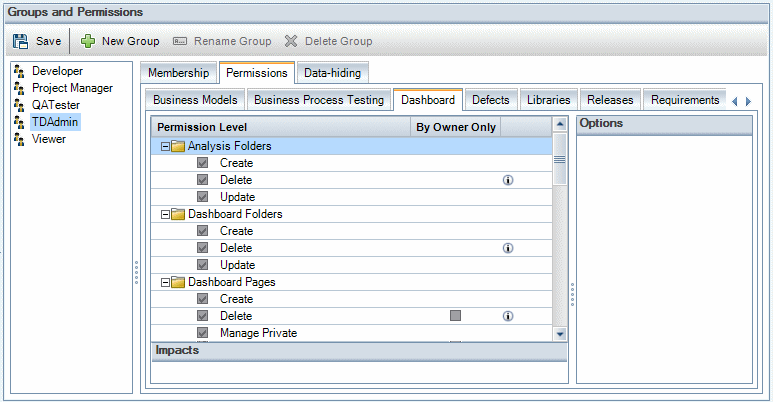Every user group has a set of privileges, or permissions, which are defined by the ALM project administrator.
Example:
Suppose a group of users called DOC has Viewer permissions. To work more effectively on the project, they need to add, modify, and delete defects. As the ALM project administrator, you can assign these privileges to the DOC group by specifying permission settings.
Note:
-
You cannot modify the privileges of a default user group. To view permissions for these groups, in the Groups and Permissions page, select the user group in the group list and click the Permissions tab. For details, see Understanding Permission Settings.
-
If you upgrade a project, and the upgraded version contains a permission that was not present in the original version, ALM automatically assigns that permission to all users in the project.
Cross Project Customization - Working with a Linked Project:
User groups defined by a template project are displayed with a template icon
 in the linked project. If you are working with a project that is linked to a template project, you cannot modify the permissions of a user group defined by the template project. You can, however, limit the records that the user group can view. For details, see Hiding Data for a User Group (Data hiding).
in the linked project. If you are working with a project that is linked to a template project, you cannot modify the permissions of a user group defined by the template project. You can, however, limit the records that the user group can view. For details, see Hiding Data for a User Group (Data hiding).
ALM Editions: Cross project customization is not available for Quality Center Enterprise Edition. For more information about ALM editions and their functionality, see the Micro Focus Application Lifecycle Management User Guide
To set user group permissions:
-
In the Project Customization window, in the left pane, click Groups and Permissions. The Groups and Permissions page opens.
-
In the group list, select the user group for which you want to set permissions, and click the Permissions tab.
A set of tabs are displayed in alphabetical order, one tab for each ALM module plus tabs for specific purposes, such as for administration. Permission levels (such as Create, Update, and Delete) for the entities available in each module are listed under the Permission Level column.

-
Click a module tab. If necessary, to see the permission levels for each entity, expand the entity.
-
If the permissions of an entity is dependent on, or impacts, the permissions of another entity, an
 icon is displayed to the right of the By Owner Only column, and the Impacts pane at the bottom of the window displays information about the impact.
icon is displayed to the right of the By Owner Only column, and the Impacts pane at the bottom of the window displays information about the impact. -
If additional options are available for a permission level, they are displayed in the Options pane at the right of the window.
-
If an entity's permission levels can only be modified by its owner, a check box appears in the By Owner Only column. For details, see Owning ALM Objects.
-
-
Select the check box for the permission levels that the selected user group should have for each entity. For details on the available permissions, see Understanding Permission Settings.
-
If a permission level has sublevels, expand the permission level to display the list of associated fields. Then select the fields that the selected user group can use.
-
Limit the capabilities of modifying a field as follows:
-
To limit the entities whose permission levels can only be modified by their owners, select the check box for the permission level in the By Owner Only column. For example, ensure that only the person who owns the record can delete the value by selecting the check box in the By Owner Only column, next to Delete in the Permission Level column. For details, see Owning ALM Objects.
-
To limit the values a user group can select from a lookup list type field, set transition rules of permissible field values in the Options pane. For details, see Setting Transition Rules.
-
-
Click the Data-hiding tab to hide data from the current user group by module. For details, see Hiding Data for a User Group (Data hiding).
-
Click Save to save your changes to the Groups and Permissions page.
















